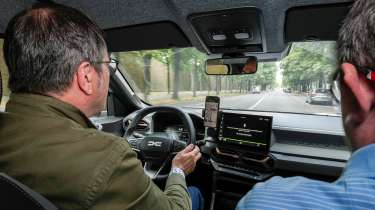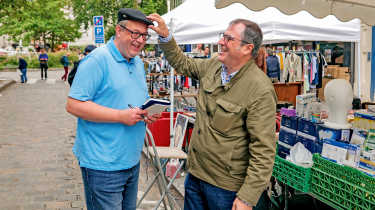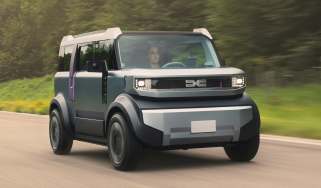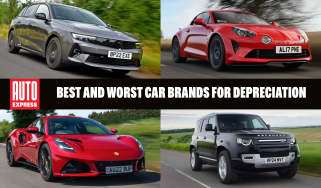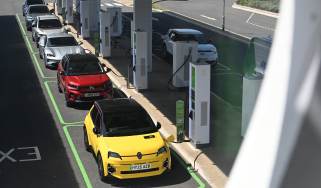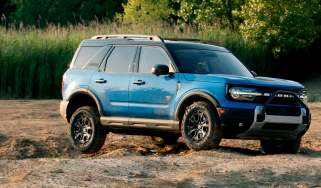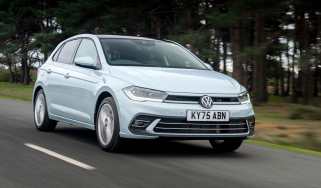Dacia CEO reveals the budget brand's masterplan
We talk to CEO Denis Le Vot and get the inside story on the new Duster and what is next for Dacia
Dacia is not your typical car company. And Denis Le Vot is certainly not your typical car-company boss. We’re two minutes into a journey around the Paris suburbs with the brand CEO at the wheel of the latest Dacia Duster, and he appears unable to resist pointing the wheels towards what look like fairly substantial speed bumps. “We can’t off-road here, but let’s at least use this SUV properly!” he grins, as he gives his firm’s latest creation an impromptu shakedown over precisely the sort of road that many examples will face on the commute or school run.
The newly crowned Auto Express Small SUV of the Year passes the test, in case you’re wondering, but that’s not why we’re here. The idea behind our visit is a simple one; we’re tired of meeting car-industry executives in flashy offices or, worse still, the pokey little rooms at the back of motor-show stands. So to kick off our exploration of the all-new Dacia Duster, we’ve gatecrashed the CEO’s Saturday morning. He’s casual; we’re casual.
In fact, as we arrive to join Le Vot for a drive in the French capital, he’s flinging a Fender Telecaster guitar case into the boot of the Duster, having just spent a few hours visiting his son for one of their regular weekend jam sessions. Influences? Traditional blues and rock, apparently; suffice it to say that the initial conversation involves BB King and Jimi Hendrix more than it does Sandero or Jogger.
It actually takes a bit of effort to get Le Vot to tell his own story, but finally a few details start to emerge. He grew up the son of a carpenter in Brittany, and swiftly developed an interest in engineering. That led him to Renault – “I felt more comfortable going there to work than going to a bank,” he recalls – where before long, his skills were farmed out to the brand’s operations in South America, specifically Venezuela.
“It was a good combination,” Le Vot says, as we stop fighting our way through side streets and start searching for a parking space on a busy Saturday morning. “My upbringing was very humble; we were simple people, who didn’t see the point in excess, or waste, or luxury add-ons. That is in my DNA, really.
“So I worked my way up through the [Renault] Group and then when Carlos Ghosn left and Luca de Meo arrived, he asked me to take responsibility for Dacia, it was a natural fit.”
Le Vot has glossed over his CV here, in truth; Venezuela was the beginning but before the opportunity came up at Dacia, he’d spent time running Renault operations in regions such as Russia and Turkey, and a stint as the Chairman of [Alliance partner] Nissan in North America.
Even so, he’s correct in saying that he was a ‘natural fit’. A keen eye for opportunities in manufacturing, synergies that can be harnessed from across the wider Renault Group and a cast-iron resistance to frippery, in the business or on the vehicles, have made Le Vot and Dacia a colossal success story.
Last year the brand’s European sales were up almost 18 per cent (in a market that rose by 14 per cent); Dacia was the second largest retail seller in the region too, a reflection of the fact that it doesn’t do big fleet deals, and keeps its private-buyer proposition clear and simple to understand. The Sandero supermini, in fact, was Europe’s biggest-selling, private-customer car in 2023.
Snapper Matt Vosper is keen to get some photos of us walking through a typical Paris market, but the idea of Le Vot actually buying anything from what is a glorified car-boot sale is pretty unrealistic. “Don’t need that, wouldn’t need that, no point in that,” he murmurs, as he surveys the contents of stalls offering everything from hats to watches.
We soon adjourn to a streetside café, where we can catch up proper over ‘un grand crème’ (Paris talk for a coffee with milk). It’s soon clear that, Saturday morning or not, Le Vot displays the same relentless enthusiasm and energy that you find in the very best top bosses. Indeed, we’re surprised to hear him say, admittedly off the cuff, that he “doesn’t sell cars for fun” (that’s where the guitar comes in, by all accounts). Yet at 59, he clearly still relishes getting up in the morning and going to work. Why?
“The best bit about what I do – and I do love what I do – is the development. I really enjoy that part,” he says. “We are a very small company in terms of management; we don’t have a crazy amount of layers. So you can be sure that I am involved in conversations where we are constantly trying to decide what the customer expectations are, and how we meet them. That sounds easy, but it’s not, because what customers expect – the features that they actually need instead of just luxury add-ons – is constantly changing, in areas like infotainment or driver-assistance systems, for example.
“I love the conversations from an engineering and business point of view, where someone says, ‘Okay, so it will cost us 10 Euros to put this feature on our cars – should we do it?’ And we get down to analysing whether it’s worth it or not. Whether, in the big picture, our customers are really going to be willing to pay that extra 10 Euros for it.”
That understanding of customers – the ‘Dacia family’ – oozes out of Le Vot’s words. That focus on private customers means no big discounts for large fleets, but a different sort of relationship with the individual buyer than pretty much any other mainstream manufacturer.
“First up, we have outstanding loyalty,” Le Vot explains. “The average Dacia customer keeps their car for eight years; that’s much higher than what you normally find in the industry. And when they do change cars, 77 per cent of Dacia customers order another one. They stay in the family.”
That lengthy ownership period meant that, for a long time, Dacia was known as a brand that popped up on the shortlists not of those in the market for a new car at all, but rather people who would otherwise be found swimming around the second-hand classified ads. That has changed, Le Vot says.
“With what the industry calls ‘conquest’, you have to understand that, in a way, there are two types of new Dacia customer,” he explains. “The first is still someone who is comparing our products with used vehicles. If you go back 10 years, this was 35, maybe 38 per cent of our new-buyer mix. That has decreased over the years to where we’re still above the industry average, but not by anywhere near as much as before.
“The second type of new Dacia buyer – and this is a much bigger proportion than it used to be – is a customer who is coming from a mainstream brand. They’ve seen prices going up and up, they’ve seen their income not rising at the same speed, and the cost of living in general is higher than ever. Suddenly they are looking hard at what they really need, and then looking at how we provide it, and saying, ‘Hey, maybe we can try that and we spend the money we save on a car elsewhere – holidays, home improvements, education, healthcare, whatever.”
The next phase is where people who might have fallen into that category but been put off by a ‘basic feel’ can be won over by design. “It’s not about lots of styling extras or glossy pieces,” he says. “If anything, it’s the opposite; we’ve removed chrome from our cars because we realised the customers would actually appreciate how that fits in design terms. It was the sort of decision that other brands might have taken six months to make; we did it in minutes.”
The company’s flagbearer for this process is, of course, the Duster that we’ve just been driving around Paris’s 13th arondissement. As the vehicle that spearheaded Dacia’s emergence as a credible brand across Europe, it’s arguably a model that comes rolled up with the greatest risks or expectations. But Le Vot is quick to boil down why the third generation of the Duster was actually relatively straightforward to develop.
“We knew already that we’d move to the CMF-B [platform] architecture with this Duster,” he says. “That meant that, in engineering terms, we had experience from Sandero and also understood how to make that platform bigger, from the Jogger. With that knowledge, and the input from design, we were able to rethink the Duster – or rather, make sure it delivers, more than ever, on our brand values. What’s different is that as long as we embrace design as a element of functionality, we can give more visual appeal as well as our traditional strengths. I don’t think anyone would argue against the idea that the design of this Duster is stronger than before – and yet there’s still nothing unnecessary.”
He’s being careful, but accurate with it. Dacia’s fan base would call the brand out immediately if it began adding needless flourishes or fake bits of rugged-looking trim. But with the Duster, the firm believes it can make people want its cars because of aesthetics along with factors such as space, practicality and value. It’s an approach that might improve the car’s fortunes in more design-led cities such as France’s capital; Le Vot candidly points out that while Duster is a huge seller in other major urban areas, including the uber-posh Cote d’Azur, style-conscious Parisians still tend to opt for BMWs, Mercedes and Audis.
Nailing the Duster is one thing; the forthcoming Bigster is another proposition entirely. Dacia has already shaken up the markets for superminis, seven-seaters and small SUVs; the tiny Dacia Spring EV has the potential to reshape the electric car market, too. But next year the brand will launch a 4.7-metre-long family SUV that could cost barely two thirds the price of a Nissan Qashqai. On paper it’s a no-brainer, yet it brings new challenges for Le Vot and his team. After all, we suggest, doesn’t the move up in size create more potential pitfalls for Dacia?
“I don’t think so,” counters Le Vot. “You’re right about Duster; we’d never say it was easy but we have sold 2.4 million of them over the years, so we have a pretty good idea of what the car’s appeal is – the challenge for the new generation. It’s spacious enough, yes, but compact – that’s key.
“Bigster will have many of the same principles as Duster but it’s in a different segment, and this is where things get interesting. We’re convinced that there is a market for it; this is a huge part of the European car market that we’re entering, somewhere we’ve never had an offering before. But are people waiting for the Bigster specifically? Are they craving a Dacia alternative to the £40,000 family SUVs that they’re being offered these days? The real truth is that we don’t know. Maybe yes, maybe not. Or perhaps they are and they don’t even know it yet.”
But it already seems like Dacia’s DNA is indeed being carried through to the Bigster project. There must be a temptation, for example, to offer the car with seven seats as well as five. No chance, says Le Vot. “That’s just not on the agenda,” he says. “The re-engineering costs of scaling up the platform [Bigster, like all modern Dacias, will use the CMF-B architecture that was originally conceived for the Renault Clio] are such an integral part of where we end up on price. So adding a third row of seats would bring complexity that would ultimately make all versions of the car more expensive. It will be a five seater only, for sure; we won’t deviate from this plan.” He does admit, though, that Bigster is unlikely to be the last C-segment model that Dacia launches; there are said to be two more in the pipeline.
Our time is nearly up; Denis has an afternoon of light exercise and relaxing ahead of him, to be followed, he says, by a lengthier run around the Paris suburbs tomorrow morning. There’s a minute or two left, though, to throw him one final curveball. If the new Duster does expand its appeal, and models such as the Jogger continue to succeed, isn’t there a danger that adding the Bigster and expanding the line-up of larger cars will just max out Dacia’s manufacturing capacity to the point where they’re limited by production, not demand?
He concedes that pieces of the brand’s industrial footprint are being rearranged slightly, but remains confident that as buyers across Europe and beyond move to Dacia, the firm will be ready to welcome them. “We operate at a very high efficiency, with many shifts in all of our factories,” he says. “We can’t lose that; it’s one of the core components of how we work.
But we have some flexibility – not just in Romania but also in our other facilities [Turkey and Morocco] – that will allow us to create space and adjust as required. There wouldn’t be much point in creating these new models if we didn’t have the scope to make enough and sell enough of them.”
It’s a fair point, delivered with typical frankness, and the usual grin. And with that, Mr Dacia is off. Even on his day off, Le Vot lives, breathes, talks and walks the brand. Unless he’s strumming a Fender, perhaps.
Now take a look at the new Dacia Sandrider...
Find a car with the experts




